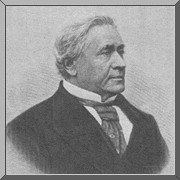
|
Faraday, when asked about the utility of his dynamo |
The term electrodynamics generally applies to forces that exist between magnetic fields, or between a magnetic field and a current-carrying wire, or between two current carrying wires. The connection between electricity and magnetism was discovered quite by accident in 1820 by Danish physicist Hans Christian Oersted. See the previous section on the magnetic field.

|
Other scientists
began looking for additional connections between electricity
and magnetism. The next breakthrough came in 1831 and the story
behind it is a is a good illustration of the rules of discovery
in the scientific community. Joseph Henry was an American part-time
scientist but mostly full-time school teacher at a private school
near Albany. During a break in the school schedule, and while
doing work with magnets, electric wires and such, he noticed
that whenever there was relative motion between a
wire and a field, a current would be caused to exist in the wire.
This is a statement of the principle of electromagnetic induction.
As luck would have it, Henry's superiors would not give him time
from his work schedule to publish, so his discovery remained
his secret. |
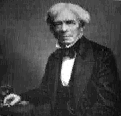 |
Meanwhile, in England, we find Michael Faraday,
born to a family of modest means and who, after being taught
how to read and count,was apprenticed to a book-binder. In the
course of his duties, he read everything he printed and was fascinated
with the work of British chemist Sir Humphrey Davy. Faraday persuaded
Davy to take him on as an assistant. Eventually, he set off on
his own to do his own experiments. In 1831, and working independently
and without knowledge of Henry's work, Faraday also discovered
electromagnetic induction and published an account of his work. see the applet at http://micro.magnet.fsu.edu/electromag/java/faraday/ |
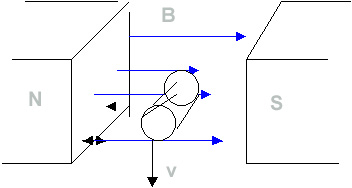
|
Consider the diagram
at left. It is intended to show a wire pushed downward
through a uniform left-to-right pointing magnetic field by some
external agent (not shown). If we assume positive charge
carriers populate the wire, these charges should be pushed along
the wire out of the page, according to the Lorentz equation.
F = qvB . Verify this with the right hand rule. Push
the wire up and the charges are pushed into the page. |
1. The AC Generator
This revelation (electromagnetic induction)
eventually led to the development of the alternating current generator,
a device that converts mechanical energy into electrical energy
by rotating a coil of wire in a magnetic field. The current so
produced is an alternating current (AC) that changes direction
with every half-turn of the coil and varies in magnitude with
the moment-to-moment angular orientation of the rotating coil
and the field that surrounds it. For much of the next twenty years,
the scientific community looked askance at AC because it was so
different from the constant-magnitude, constant-direction current
supplied by batteries. Then in the 1850s came a breakthrough that
helped shape the course of scientific development in E & M.
A French instrument maker ,M. Hipolite Pixii, devised an improvement
to the AC generator called the split-ring commutator. Whereas
an alternating current was still produced in the rotating coil,
it was collected in such a way that it could be fed to the outside
world as a pulsating direct current. Given that the development
of the battery as a source of electric current has not improved
significantly in the amount of energy available, the generator
that can convert any plentiful supply of mechanical energy in
electrical energy represents one of the significant developments
in the last 200 years.
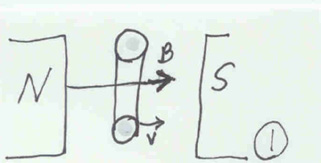
|
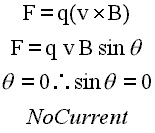
|

|
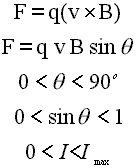
|

|
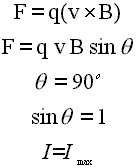
|

|
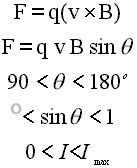
|
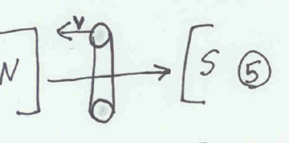
|
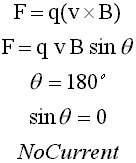
|
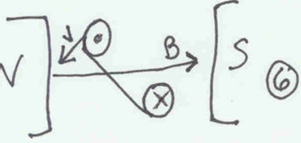
|
Same as figure #2 Except current is reversed |
Go to
http://www.phys.ufl.edu/~phy3054/magnet/inductn/gens/Welcome.html
and
http://www.walter-fendt.de/ph14e/generator_e.htm
Here is an applet for a simple generator
http://www.sciencejoywagon.com/physicszone/lesson/otherpub/wfendt/generatorengl.htm
http://micro.magnet.fsu.edu/electromag/java/generator/ac.html
here is an applet on the vector cross
product.
http://www.lon-capa.org/~mmp/kap17/vector/vector.htm
2. The Electric Motor
When we think of inventors and inventions, the work of Thomas Edison comes to mind. In 1878, he assembled a research and development team (the first to do so, by the way) for the expressed purpose of improving the incandescent lamp so that it had a high enough resistance to be used in parallel. History shows that he was successful. The invention of the DC motor, on the other hand, came about as an industrial accident. The Vienna Exhibition of 1873 was intended to be a showcase of the newest technology in the world. The plan was to have a large hall lighted by carbon arc lamps supplied by two generators running in tandem which in turn were to be driven by steam engines. On a fateful day, some unknown workman fired one of the steam engines to drive one of the generators. Unexpectedly, he noticed that the coil of the second generator was turning without being driven by its steam engine. Apparently, the output of the first generator was driving the coil of the second. In retrospect, that should not have come as any surprise. Passing a current through the coil of a motor creates a magnetic field around the coil. That field is subsequently opposed by the field of the permanent magnet built into the generator. The coil cannot be expelled, but it can turn. The result of this development is that we can 1) have a source of mechanical energy at some remote site which 2) drives a generator that converts the energy to its electrical form and sends it along a wire. At the other end of the wire we can use the electricity to drive a motor, converting the energy back to its mechanical form once again.
DC motor applet
http://www.walter-fendt.de/ph14e/electricmotor.htm
These
sites are links to an entire course in E & M
http://theory.uwinnipeg.ca/physics/charge/node1.html
http://library.advanced.org/16600/intermediate/static
electricity.shtml
http://www.phys.ufl.edu/~phy3054/extras/contents/Welcome.html
http://chemweb.richmond.edu/~rubin/pedagogy/132/132notes/132notes/EM.html
3. The Transformer
In the previous paragraph it was stated very matter-of-factly that we could generate electricity and send it along a wire without effort. In fact there is cost for sending current along a wire. Some of the energy carried by the wire is converted to heat. If the wire in question is in your electric blanket, this energy conversion is good. If the wire is between here and East Overshoe, heating a wire running through the Maine woods is not very practical. In fact, the amount of energy converted to heat varies directly with I^2. That means electricity carried at high current causes lots of heat losses in the wire. It also means that any reduction in the current carrying the energy results in energy savings. Enter the transformer. This AC device consists of two coils in close proximity to each other. The first (primary) coil is attached to an AC generator that produces a variable current in the primary. This variable current causes to exist a variable magnetic field which ebbs and flows, sweeping across the other (secondary) coil, inducing a current to be established there. It happens that there is a relationship between voltage (V) in a coil and the number (N) of turns of wire in the coil
We know that
That means that if the secondary has more turns of wire, say Ns/Np = 100/1, then the voltage in the secondary is increased by a factor of 100 and the current in the secondary is decreased to .01 of what it was in the primary. The transformer is the third part of our energy transportation. A generator converts mechanical energy to electrical energy; a transformer steps up the voltage for transportation purposes; another transformer steps the voltage down at the consumer end; and finally the consumer is free to do what she wants with the energy, including changing it into mechanical again.
and a charged particle in the field
http://www.walter-fendt.de/ph14e/lorentzforce.htm
transformer Applets
http://micro.magnet.fsu.edu/electromag/java/transformer/
http://www.perry-lake.k12.oh.us/phs/Classdept/ScienceDept/Physics/ClassTopics/MagneticInductance/transformers.html
SIDE BAR
Check out these related web sites for interesting applications of these topics
http://howthingswork.virginia.edu/magnetically_levitated_trains.html
http://howthingswork.virginia.edu/electric_power_distribution.html
http://howthingswork.virginia.edu/electric_motors.html
http://howthingswork.virginia.edu/tape_recorders.html
Last edited12/24/05